2016 MXA RACE TEST: EVERYTHING YOU NEED TO KNOW ABOUT THE 2016 SUZUKI RM-Z450
Q: FIRST AND FOREMOST, IS THE 2016 SUZUKI RM-Z450 BETTER THAN THE 2015 RM-Z450?
A: No. Why not? Face it, Suzuki has been treading water for a few years now. Instead of making meaningful changes, they have been slapping Band-Aids on the RM-Z450. For 2016, Suzuki used teeny-tiny Band-Aids.
Q: WHAT DID SUZUKI CHANGE ON THE 2016 RM-Z450?
A: We were not overly impressed with the changes that Suzuki made to last year’s RM-Z450 (TAC forks, S-HAC launch control, longer kickstarter, 4-percent-lighter frame, new shift cam and Y-shaped radiator hose juncture), and that list is twice as extensive as the list of 2016 mods. The three changes for 2016 aren’t going to set the world on fire.
(1) Bold New Graphics: Just kidding! These aren’t BNG (Bold New Graphics). At best, they are MNG (Mild New Graphics). The only change you can actually recognize is that one of three 10-inch-long stripes on the radiator wings has been changed from red to white.
(2) S-HAC launch control. S-HAC stands for Suzuki Holeshot Assist Control. It is the only launch control system on the showroom floor with two maps dedicated to the starting line. You can choose between stock, the A-Mode for concrete or the B-Mode for deep-loam starts. The modes can be selected via a handlebar-mounted button. It’s in its second year but has been revised for 2016.
(3) Front brake caliper. Suzuki is the last of the “Big Six” without an oversized front rotor; however, Suzuki has replaced last year’s Nissin caliper with a smaller and lighter caliper. How is the performance? Suzuki boasts in its brochure that it has the “same stopping performance” as before. When you had bad brakes to begin with, the same stopping power doesn’t rate as an improvement.
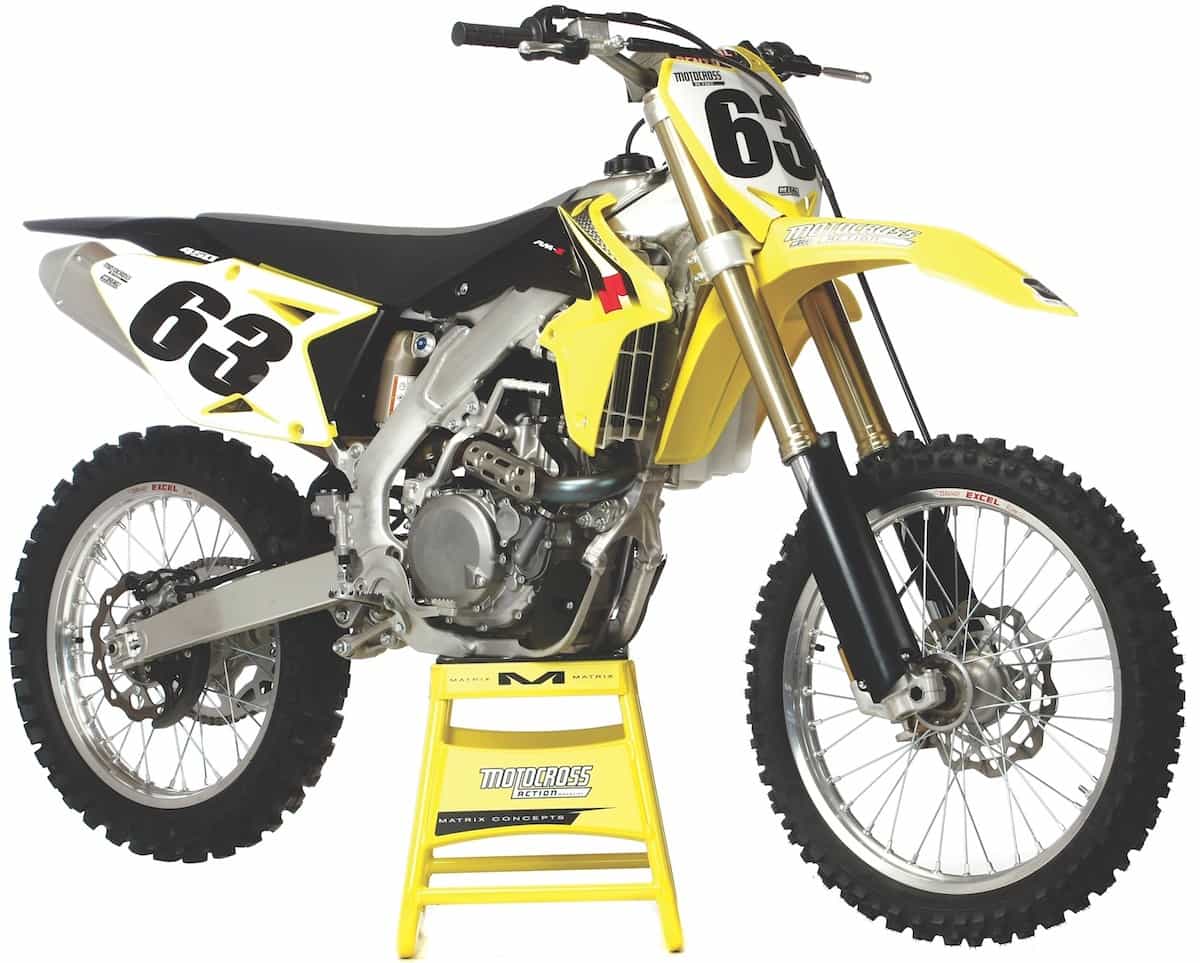 2016 Suzuki RM-Z450: We forgive you if you can’t tell the 2016 Suzuki from the 2015 model. There is only one way to tell and it’s hard to spot.
2016 Suzuki RM-Z450: We forgive you if you can’t tell the 2016 Suzuki from the 2015 model. There is only one way to tell and it’s hard to spot.
Q: WHAT WOULD MXA HAVE LIKED SUZUKI TO CHANGE FOR 2016?
A: We run this list in every Suzuki test. Guess what? Suzuki ignores it. But, there is always hope for 2017. Here are the problem areas as we see them, but maybe it’s just us.
(1) Looks. It doesn’t have muttonchops, bell-bottom pants and love beads, but it certainly hasn’t kept up with the times. As a side note, when Honda sent over the photo of the 2016 CRF450, we e-mailed to tell them that they sent us the wrong photo. We were positive they had sent us the 2015 CRF450 studio photo instead of the 2016 photo. Why? The photo had “2015 Honda CRF450” printed on the file name. Honda said, “No mistake. We didn’t make any changes to the plastic or graphics for 2016, so the 2015 photo will work as the 2016 photo.” Later, Honda sent us a 2016 photo, or at the very least a photo with a “2016 Honda CRF450” file name. Here’s the kicker. When we got the 2016 Suzuki RM-Z450 photos, we thought Suzuki had done the same thing. When we questioned the photo, they pointed at the color change on the minuscule tank stripe. By golly, they were right. How could we have missed it? The look of the RM-Z450 is eight years old. That’s cool for the owner of a 2008 RM-Z450, because his bike looks like a 2016; but, it’s sad for the guy who buys a 2016 model, because his bike looks like a 2008.
(2) Brakes. You can race with Suzuki’s small-diameter front brake, but you’ll never be able to say, “I out-braked the guy in front of me on the downhill.”
(3) Clutch. Suzuki’s clutch is the country-bumpkin, distant cousin of KTM’s hydraulic, Belleville-washer, integrated-primary-gear, steel-basket clutch. Order stiffer clutch springs before you leave the Suzuki dealership.
(4) Rear brake adjustment. Danger, Will Robinson, danger! There must be free-play in the master cylinder’s slotted clevis or the rear brake will overheat. We’d like a wider range of possible brake-pedal heights.
(5) Tonnage. On MXA’s scale, the RM-Z450 was the heaviest bike of 2016. How heavy? 13 pounds heavier than a KTM 450SXF.
 TAC air: The Showa Triple Air Chamber forks offer thousands of possibilities, most of them wrong.
TAC air: The Showa Triple Air Chamber forks offer thousands of possibilities, most of them wrong.
Q: HOW DOES THE 2016 SUZUKI RM-Z450 RUN ON THE TRACK?
A: This is a really nice engine. It produced a very clean-running powerband that works best in the low-to-mid range. It’s not especially fast, but it has almost perfect power placement. At no point in a race do you feel like you have more power than the bikes around you, but you do have immediate pick-up off the bottom that transitions into a supremely usable mid-range surge. It has a very nice feel that builds confidence thanks to its excellent hook-up. If you are going to win races on an RM-Z450, it is because of the quickness off the bottom and healthy midrange.
The key to success is to shift at the perfect spot on the curve. Where is that spot? 9000 rpm. After 9000 rpm, the RM-Z450 can’t run with horsepower beasts like the 450SXF, Husky FC450 or YZ450F. If you try to play the high-rpm game, they will shut you down. Shifting before peak is the only way to stay in the hunt.
Q: HOW DOES IT RUN ON THE DYNO?
A: We didn’t expect the totally unchanged engine in the 2016 RM-Z450 to run any better on the dyno than it did in 2015 or 2014. We could lay three years worth of dyno charts on top of each other and not see an iota of difference. Peak horsepower was 54.88 horsepower at 9200 rpm. Out of the Big Six 450s, that is the fifth most horsepower, only beating 53.03 horsepower CRF450. When compared against the 2016 KTM 450SXF, the RM-Z450 gives up 1-1/2 horsepower at 7000 rpm, 1-1/3 horsepower at 8000 rpm, 2-3/4 horsepower at 9000 rpm and 3-1/2 horsepower at 10,000 rpm. If the situation calls for a drag race off the line, up a hill or down a long straight, the Suzuki will feel like a Fiat 500 up against a Dodge Viper.
 Little sister: Putting the weakest brakes on the heaviest bike is not a winning formula.
Little sister: Putting the weakest brakes on the heaviest bike is not a winning formula.
Q: DO THE SUZUKI’S PLUG-IN MAPS WORK?
A: Yes. The Suzuki has stock, mellow and aggressive maps that can be changed in a few seconds. Here is how they work: The stock coupler is no coupler at all, just a protective dust cover. It works across a wide range. Strangely, the dyno liked the stock map best. It delivered the most horsepower, but it was not the first choice of test riders. The gray coupler is the mellow map and was designed to work best on hard, dry and slippery tracks. Most MXA test riders liked this plug-in and used it when track conditions were dry and sketchy or on jump tracks where the premium was transitioning from jump to jump. The white coupler is the aggressive map. It leans out the mixture and livens up throttle response. The dyno readings never revealed the advantages of the white plug-in that the test riders felt on the track, but when the dirt was good, this was the map of choice.
Q: WHAT’S THE DEAL WITH THE S-HAC LAUNCH CONTROL SYSTEM?
A: Launch control is where the brave new world of electronics meets the down-and-dirty world of racing; however, each factory has a different take on how to configure its system. On a KX450F, launch control stays engaged until the rider shifts to third gear. On the Yamaha YZ450F, launch control works off an algorithm that matches throttle position and rpm to deactivate launch control approximately 30 feet off the gate. On the KTM 450SXF, launch control is engaged until the rider chops the throttle by more than 30 percent. On the Honda CRF450, launch control is non-existent, but we bet that it will come on the 2017 model.
As for the 2016 RM-Z450, Suzuki’s engineers reprogrammed last year’s S-HAC settings so that the concrete-friendly A-Mode (signaled by a slow flashing indicator light when the button is pressed for less than 1 second) stays engaged for 1.2 seconds after the start or until you shift to third gear. The loam-specific B-Mode (signaled by a fast-flashing indicator light when the button is pressed for 2 seconds) stays engaged for 4.5 seconds after the start, until you shift to fourth gear, or until you chop the throttle, whichever comes first.
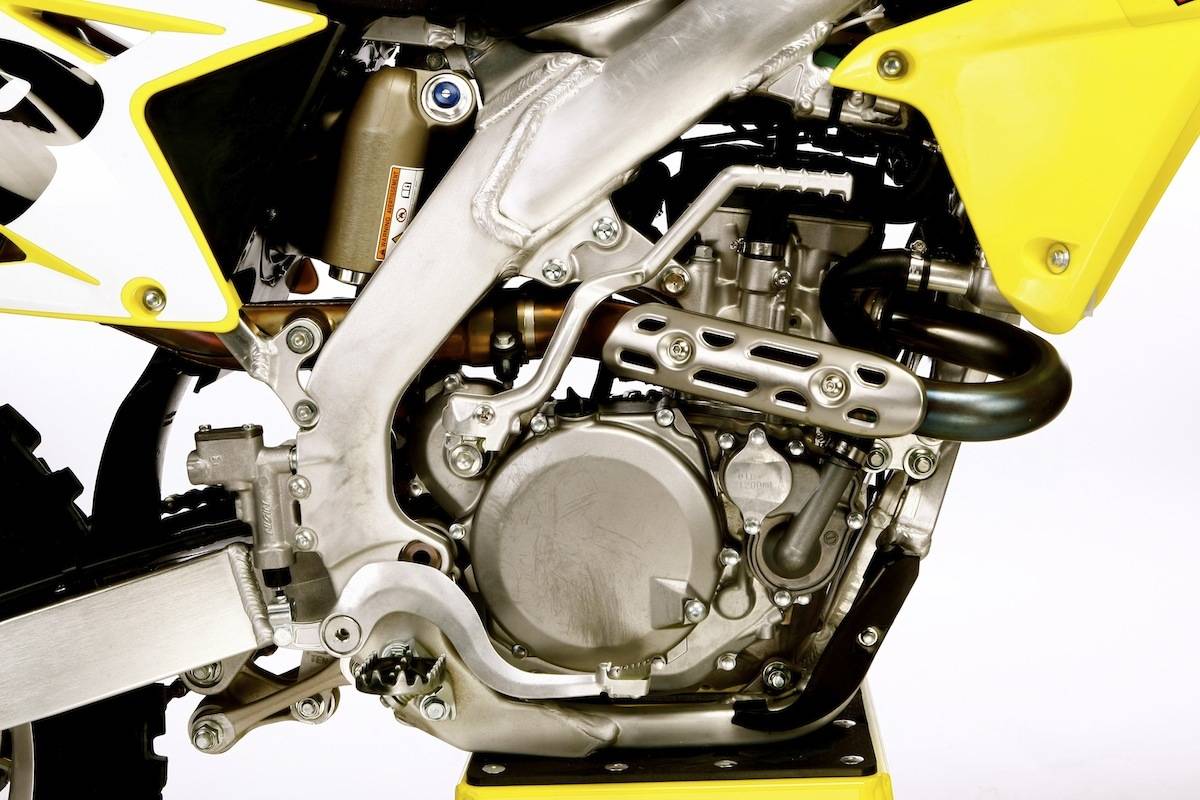 Under the hood: Not blessed with oodles of horsepower, the RM-Z450 makes up for that with usability. It’s a good engine.
Under the hood: Not blessed with oodles of horsepower, the RM-Z450 makes up for that with usability. It’s a good engine.
How does it work? Most MXA test riders were only interested in the A-Mode. It retards the ignition to control wheelspin on hard-pack dirt or concrete. Then, once you are off the concrete, it quickly returns to the normal map. All well and good. The B-Mode is like the “Boost” button on Excitebike. It is designed to be used on loamy starts. It advances the ignition timing to the point where the bike makes more power than it does with the aggressive white ECU coupler installed. Sometimes the B-Mode was good, but other times it led to a wheelie/spin/chop scenario. The B-Mode is dirt-sensitive, so practice before electing to use it at a big race. Sadly, we had trouble getting the ECU to engage the A-Mode, you have to press the button for a very brief time to get the slow flashing light.
Q: HOW DOES THE 2016 RM-Z450 HANDLE?
A: In 2013, Honda embraced Suzuki’s “turn at all costs” philosophy in an attempt to erase the memory of four bad CRF450 year (2009-2012). The problem for Honda’s engineers was that they couldn’t live with the looseness that comes with an aggressive chassis setup. The price you pay for super-sharp cornering is twitchiness and a rear end that resembles a swinging bar door during Happy Hour. Honda gave up on its Suzuki-clone chassis in 2016, putting on longer forks to raise the head angle back to a safer, slacker and more relaxed angle (and even put a notation in the owner’s manual saying that the fork height on the 2016 CRF450 was not adjustable).
Suzuki, to its credit, has never cracked. The bikes have been twitchy since 1982—and Suzuki is proud of it. There is no doubt that the 2016 RM-Z450 is unsettled at speed, but you gotta give to get. If you want a bike that can turn inside any bike, this is it. It’s a compromise that we can live with, because this chassis rewards aggressive riding in the tight stuff.
It would be wrong to say that cornering is the only thing the RM-Z450 does well, but not entirely wrong. When it isn’t darting around tight turns and flicking through switchbacks, it’s just average—and at high speeds it is atrocious. The RM-Z450 is a great Supercross, arenacross, fairgrounds, jump-track or smooth-track machine; however, as an outdoor bike, on a rough track with big bumps and high speeds, it requires caution.
Q: HOW MUCH DOES IT WEIGH?
A: It’s a tub of lard. At 240 pounds, this is the heaviest 450cc motocross bike you can buy in 2016. That may sound harsh, but the KTM 450SXF weighs 227 pounds—and it has an electric starter and battery. Whittling 13 pounds off of an RM-Z450 to get it down to KTM weight would cost thousands of dollars.
Q: HOW GOOD ARE THE SHOWA SFF AIR TAC FORKS?
A: If you are a Suzuki loyalist, tried and true, who bleeds yellow and is a serial RM-Z450 buyer, then you remember the bleak days back in 2014 when the RM-Z450 came with single-spring SFF forks that felt like they were filled with concrete. Those were the worst forks ever, but the RM-Z450’s Showa TAC Air forks are barely a step up the ladder. In our heart of hearts, we wish that we could embrace Triple Air Chamber forks, but it’s hard to get past how difficult they are to live with for what turns out to be average but spikey performance. And since Suzuki and Kawasaki share the same TAC forks, you’d think that getting them dialed in would be enhanced by the shared knowledge. It isn’t. Suzuki’s and Kawasaki’s TAC fork settings are on different planets when it comes to feel.
Given that we liked the KX450F forks and hated the RM-Z450 forks, we tried to swap as many internal parts as possible from the KX’s TAC forks to the Suzuki’s. Unfortunately, we could not swap all of them for an acceptable amount of money. In the end we sent the forks off Pro Circuit’s Bones Bacon and had him put in his customer spec. It was a night and day difference (www.procircuit.com).
We have come to accept that we are headed for an air-fork future, even though the coil-spring-equipped Yamaha SSS forks are light years better than any air fork made. The bean counters will win the fork wars, because air forks come down the assembly line faster, cost less to produce and save 2 pounds, which means without them the 2016 RM-Z450 would weigh 242 pounds. Now it weighs 240 pounds, but has light, but almost useless forks.
Here is the most important thing to know about the RM-Z450 TAC forks. The main air chamber (on top of the fork cap) and balance chamber (on the bottom of the fork leg) work in opposition. They are in a constant tug of war. Putting more air in one chamber changes its relationship to the other chamber (so much so that the forks get longer and stiffer when the main chamber air pressure is increased and vice versa). MXA’s best setup involves choosing a main air chamber pressure that makes the forks feel supple across rough ground and doesn’t dive too much (and that could mean Pro riders going into the 190s and slow riders coming down to the 160s). Then we set the air pressure in the balance chamber to vary the stiffness or softness of the first 4 inches of stroke (we always tend to run higher pressure in the balance chamber than in the main chamber). As for the third chamber, called the “outer chamber,” Suzuki doesn’t recommend any air pressure in it; we ran 10.5 psi.
Q: WHAT DID WE HATE?
A: The hate list:
(1) Clutch. If you use this clutch, you will lose this clutch. Keep your left hand in your pocket at all times.
(2) Weight. If motocross bikes were sold by the pound, this would be a great deal, but there is a reason why Kobe beef costs more than chuck roast.
(3) Brakes. Suzuki’s brakes are old-school. In fact, they are last in their one-room schoolhouse.
(4) R&D. It is incredibly expensive to change the major components on a motocross bike. It is much cheaper to have your outside vendors update their products and just bolt them on the same old frame, engine, transmission and design. It’s shopping-cart R&D.
(5) Black rear fender. We didn’t get it when it first showed up in 2013—and we still don’t get it. We understand that the black rear fender combines with the black seat cover to make the top half of the RM-Z contrast with the bottom half; however, Suzuki’s yellow plastic looks brighter and stays cleaner than any other color on the track. Suzuki should embrace yellow.
(6) Aesthetics. You don’t need a Hot Tub Time Machine to go back to 2008. It’s at your Suzuki dealership.
(7) SFF TAC Air forks. They spike at mid-stroke and grind to a halt at the end. Not pleasant.
 Snap to it: Suzuki’s plug-in maps are behind the left radiator.
Snap to it: Suzuki’s plug-in maps are behind the left radiator.
Q: WHAT DID WE LIKE?
A: The like list:
(1) Handling. If you’ve never been very good at cornering, an RM-Z450 will fix that.
(2) Power. This engine is better than its raw numbers. It has a sweet powerband and usable delivery, and what it lacks in numbers it makes up in feel.
(3) Tires. Bridgestone’s 403/404 tire combo is an MXA favorite. When these tires go away, might we suggest a Bridgestone X40 rear with an X30 front.
(4) Cooling. The RM-Z450 used to boil over while idling in the pits. Last year’s Y-juncture seems to have helped with that.
Q: WHAT DO WE REALLY THINK?
A: Even though it doesn’t have class-leading horsepower, clutch, brakes, forks, stability, weight, suspension or looks, we like this bike. Old news, because we liked the exact same bike last year, but we love its competitors.
MXA’S SUZUKI RM-Z450 SETUP SPECS
This is how we set up our 2016 Suzuki RM-Z450 for racing. We offer it as a guide to help you get your own bike dialed in.
SHOWA SFF TAC FORK SETTINGS
The big plus of air forks is that they can be adjusted for riders from 220 pounds to 140 pounds. Of course, this only applies to your bike if you’ve gone on a mega eating binge or have been a contestant on “Naked and Afraid.” Otherwise, you only have to worry about the correct air pressure for your weight, not somebody else’s. Job number one is to find the main-chamber air pressure that feels right for your weight, track and riding style. Once you have the main pressure in the ballpark, use the balance-chamber pressure to fine-tune the feel. It works like this: more air pressure in the balance chamber will make the forks feel softer; less air will make them stiffer. For hard-core racing, we recommend this fork setup for the 2016 Suzuki RM-Z450 (stock specs are in parentheses):
Inner spring rate: 183 psi (171 psi)
Outer spring rate: 10.5 psi
Balance spring rate: 190 psi (171 psi)
Compression: 16 clicks out (8 clicks out)
Rebound: 14 clicks out
Fork-leg height: 5mm up
Notes: You cannot recheck the air pressure with your fork pump because the high air pressures in TAC forks leak back into the pump, preventing an accurate reading. Use the pump to reset the air pressure to your desired setting, which works best when the forks cool down. It helps if you write your air pressures down in a notebook (or on the front fender as the MXA wrecking crew does).
SHOWA SHOCK SETTINGS
We have fewer rear suspension concerns on the RM-Z450 than we do the front. Why? How well the front fork absorbs the bumps plays a big role in the attitude of the shock 5 feet later. Forks that are too stiff will load the rear end, while forks that are too soft will cause it to kick. Fix the front first and the rear will thank you. For hard-core racing, these are MXA’s recommended 2016 Suzuki RM-Z450 shock settings (stock settings are in parentheses).
Spring rate: 56 N/m
Hi-compression: 2-1/4 turns out (2 turns out)
Lo-compression: 12 clicks out
Rebound: 12 clicks out
Race sag: 105mm
Notes: The best strategy for finding the perfect fore/aft balance is to use the high-speed compression adjuster to level the chassis in motion. Turn it in to raise the rear and turn it out to lower the rear. This isn’t going to be measurable at sag, but instead works when the shock is pressurized by movement. We turn the high-speed out a quarter turn.
MXA’S 2016 SUZUKI RM-Z450 VIDEO


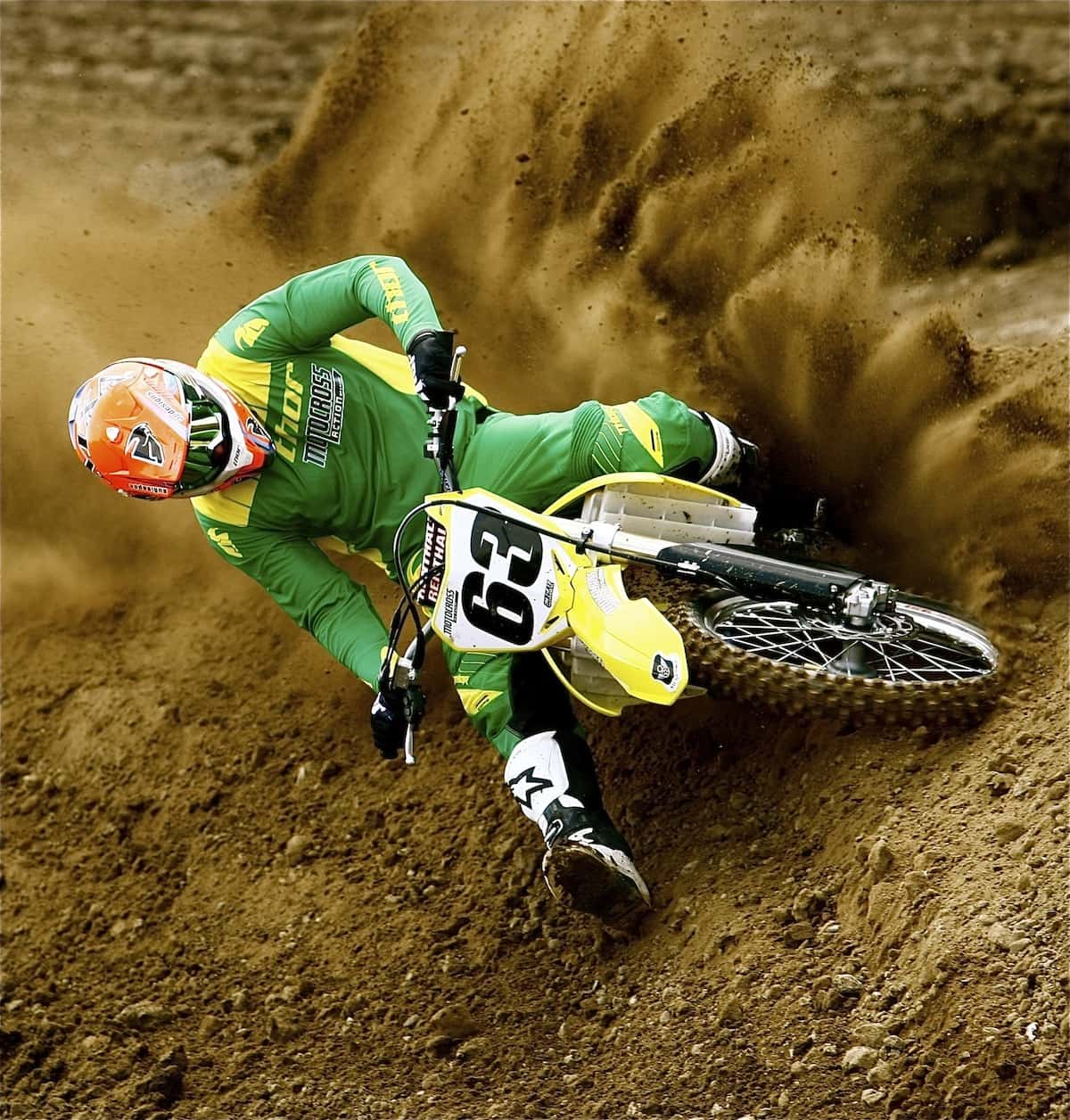


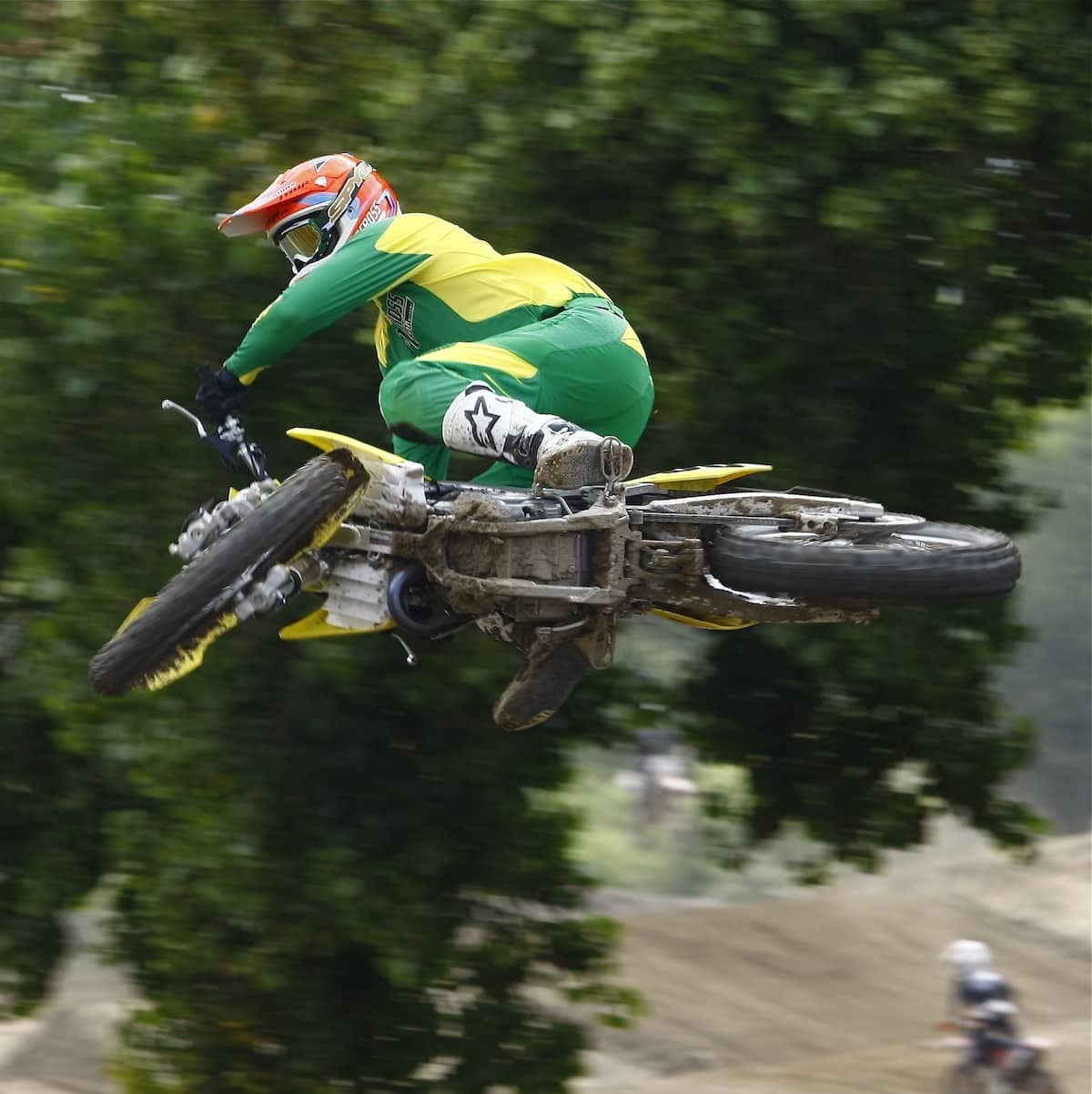
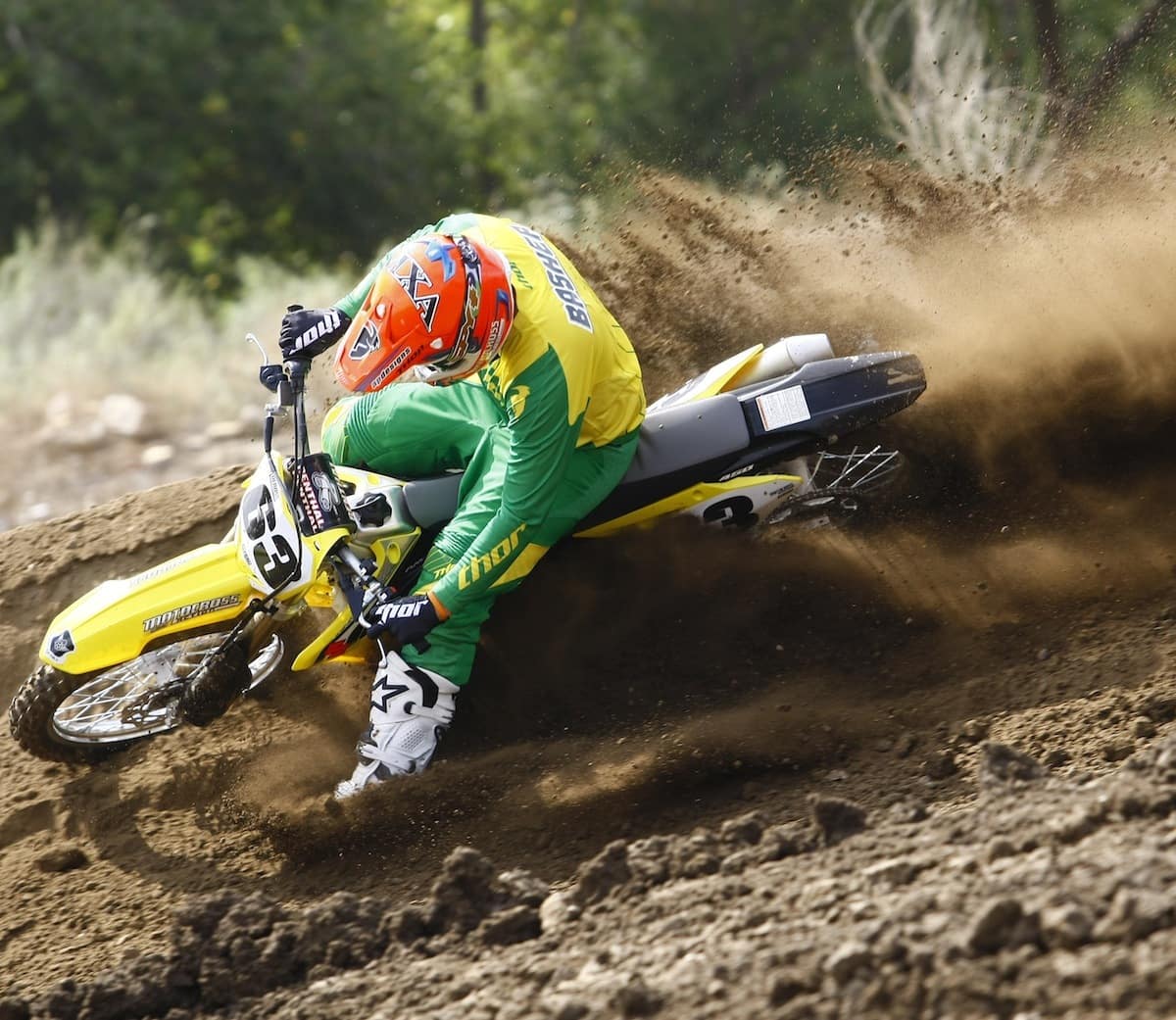





Comments are closed.